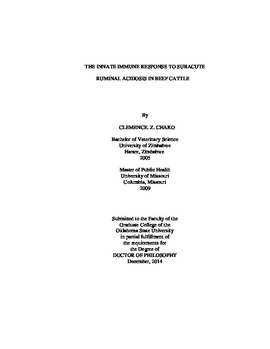| dc.contributor.advisor | Step, Douglas L. | |
| dc.contributor.author | Chako, Clemence Zvidzai | |
| dc.date.accessioned | 2016-01-20T15:44:29Z | |
| dc.date.available | 2016-01-20T15:44:29Z | |
| dc.date.issued | 2014-12 | |
| dc.identifier.uri | https://hdl.handle.net/11244/25642 | |
| dc.description.abstract | Background: Subacute ruminal acidosis (SARA) is a metabolic disease that affects both dairy and beef cattle. The effects of SARA have been extensively studied in dairy cattle, but information in beef cattle is limited. Grain-induced subacute ruminal acidosis is associated with systemic inflammation in both beef and dairy cattle. The insidious nature of SARA, coupled with lack of specific signs means that the condition is quite difficult to diagnose in beef cattle. | |
| dc.description.abstract | Hypotheses: SARA occurs naturally in beef cattle that are undergoing preconditioning at a backgrounding facility. SARA causes ruminal bacteria population changes coupled with increase in levels of free endotoxin and biogenic amines in the rumen. The ruminal changes are associated with increased levels of endotoxin and increased expression of inflammatory cytokine in broncho-alveolar lavage (BALF) and blood. | |
| dc.description.abstract | Materials and Methods: Rumenocentesis was performed to evaluate the occurrence of SARA in cattle being fed preconditioning diets. Ruminal fluid pH was also measured in animals that were identified as having bovine respiratory disease. Ruminal bacteria population changes were evaluated using qRT-PCR. Endotoxin concentration in ruminal fluid and plasma was quantified using a kinetic chromogenic Limulus Amoebocyte Lysate test. The expression inflammatory cytokines in BALF and blood was assessed with qRT-PCR. An HPLC method was developed to quantify biogenic amines in ruminal fluid. | |
| dc.description.abstract | Results: Rumenocentesis was performed without complications. Thirteen out of sixty (22%) cattle had ruminal pH less than or equal to 5.6 on day 21 in one the studies. Lactate-utilizing Gram negative bacteria, Megasphaera elsdenii was significantly up-regulated in groups of animals being fed high amounts of fermentable carbohydrates. Ruminal fluid and plasma endotoxin concentration increased with time in animals being fed varying amounts of highly fermentable carbohydrates. The concentration of endotoxin was correlated with the quantity of highly fermentable carbohydrates in the diet. The concentration of biogenic amines was higher in animals receiving higher amounts of highly fermentable carbohydrates. Pro-inflammatory cytokine were upregulated in both ruminal fluid and blood for the first two weeks. On the third week, IL-1B; and TNF were down-regulated. | |
| dc.description.abstract | Conclusion: The innate immune response to SARA resembles endotoxin tolerance. Endotoxin tolerance needs further investigation in cattle. | |
| dc.format | application/pdf | |
| dc.language | en_US | |
| dc.rights | Copyright is held by the author who has granted the Oklahoma State University Library the non-exclusive right to share this material in its institutional repository. Contact Digital Library Services at lib-dls@okstate.edu or 405-744-9161 for the permission policy on the use, reproduction or distribution of this material. | |
| dc.title | Innate immune response to subacute ruminal acidosis in beef cattle | |
| dc.contributor.committeeMember | Malayer, Jerry Rhea | |
| dc.contributor.committeeMember | Streeter, Robert N. | |
| dc.contributor.committeeMember | Krehbiel, Clinton R. | |
| dc.contributor.committeeMember | DeSilva, Udaya | |
| osu.filename | Chako_okstate_0664D_13691.pdf | |
| osu.accesstype | Open Access | |
| dc.type.genre | Dissertation | |
| dc.type.material | Text | |
| thesis.degree.discipline | Biomedical Sciences | |
| thesis.degree.grantor | Oklahoma State University | |
